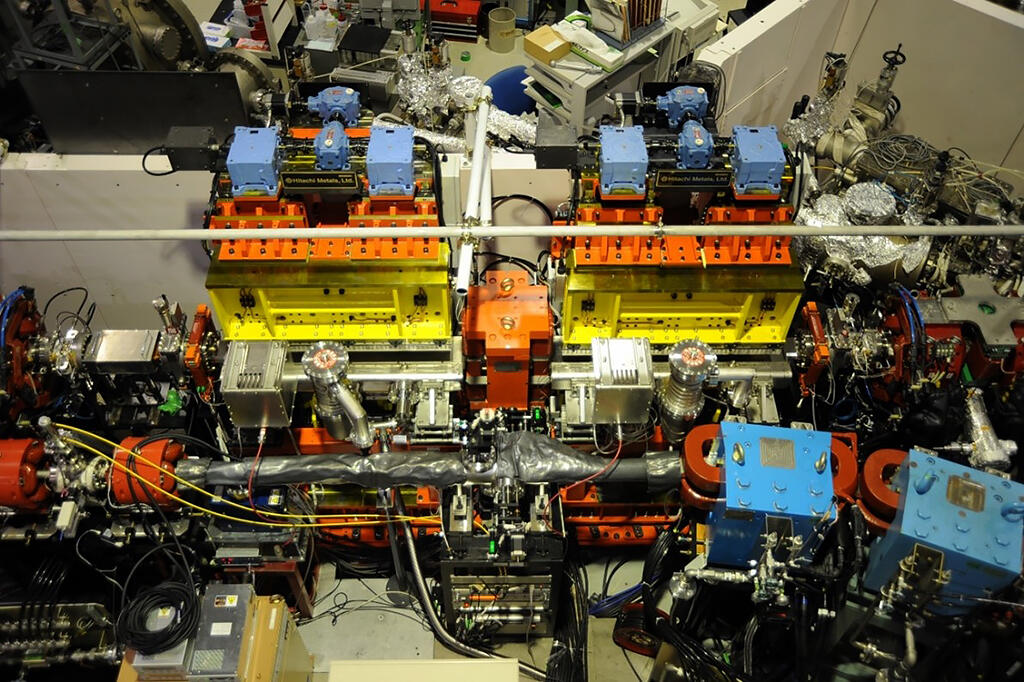A collaborative research group led by senior researcher Tatsuo Kaneyasu of the Kyushu Synchrotron Light Research Center, Professor Yoshifumi Takashima and engineer Atsushi Mano of the Nagoya University Small Synchrotron Radiation Facility, Professor Yasumasa Hikosaka of Toyama University and Professor Masahiro Katoh of the Hiroshima Synchrotron Radiation Center, Hiroshima University, using the synchrotron radiation facility UVSOR of the Institute for Molecular Science, demonstrated that the time difference between two synchrotron radiation fluxes lasting only a few femtoseconds can be controlled with a high time accuracy of a few attoseconds.

Provided by NINS/IMS
When accelerated to almost the speed of light (about 300,000 km/s) and made to move in a meandering motion using a device called an undulator, electrons emit intense light. When two such devices are placed in tandem, two light waves (wave packets) lasting as short as a few femtoseconds (one femtosecond is one thousand trillionth of a second) are emitted in succession. By placing a special device that allows electrons to take a slight detour between the two undulators, the time difference between the two wave packets can be precisely controlled. Although the research group has successfully used such light to observe ultrafast phenomena occurring in the atomic world and to control the quantum states of atoms, the question remains as to whether light with a real time structure is generated.
The research group first fabricated a new Mach-Zehnder interferometer to investigate the time structure of wave packets hidden in synchrotron radiation pulses. In the experiment, the time interval between the wave packets emitted by two undulators in the extreme ultraviolet wavelength range was precisely measured using interference between the quantum states of atoms. They placed electrons in 5p orbitals (electrons in an atom are arranged in separate shells) while the electron detour between the two undulators is gradually lengthened using a phase shifter magnet. They then detected the fluorescence emitted by helium atoms excited to the 5p orbital (the 5p orbital is contained in the fifth shell from the center). They observed that the fluorescence intensity changed periodically.
This change in fluorescence intensity indicates alternating strengthening and weakening interference as the time interval between the two wave packets gradually increases. The research group compared the time difference between the two wave packets obtained by this method with the experimental results obtained by Mach-Zehnder interferometry and found it to be in good agreement. This demonstrated that undulators can be used to generate wave packets with controlled waveforms with a high temporal precision of a few attoseconds in a variety of wavelength ranges.
"The joint research team measured the time structure of synchrotron radiation using two different methods and obtained data showing that the time structure can be controlled with attosecond precision," says Professor Kato. "Moving forward, we would like to use such light to develop functional materials and high-speed operating devices, as well as to understand radiation damage to biomolecules."
■ Undulator: A type of synchrotron radiation generator. It can generate highly directional, quasi-monochromatic synchrotron radiation using a magnet that periodically changes polarity to induce a meandering motion in electrons.
■ Mach-Zehnder interferometer: A device that uses an optical element called a beam splitter to split light into two parts, pass them through different paths and then merge them with another beam splitter to observe how they interfere with each other. By changing the length of the two paths, the two lights can interfere with each other with a time lag.
Journal Information
Publication: Scientific Reports
Title: Double-pulsed wave packets in spontaneous radiation from a tandem undulator
DOI: 10.1038/s41598-022-13684-2
This article has been translated by JST with permission from The Science News Ltd.(https://sci-news.co.jp/). Unauthorized reproduction of the article and photographs is prohibited.




